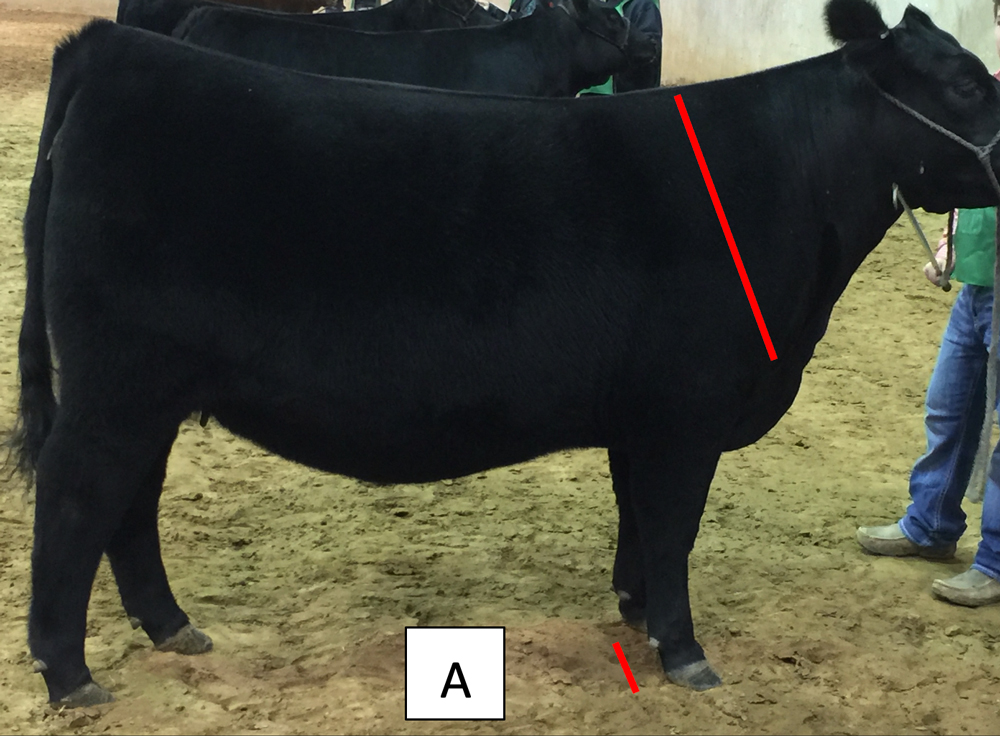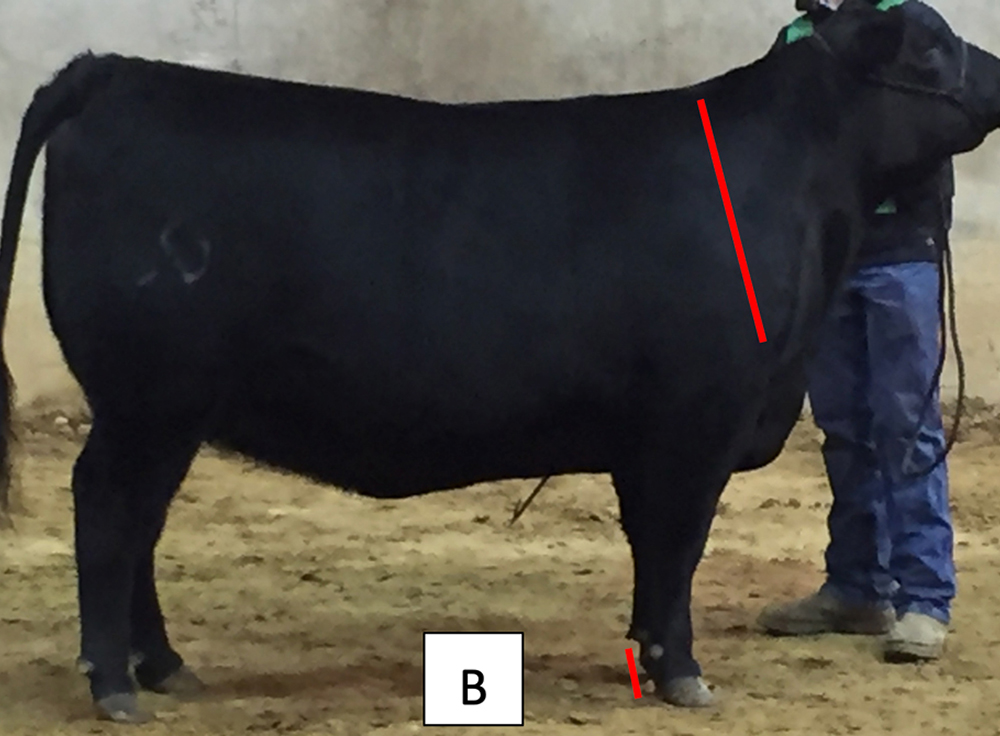Additional contributing authors: Sarah Loughridge, Heather Shultz, Dylan Davis, and Hailey Robinson.
The history of beef cattle evaluation spans well over a century. Livestock selection in a formal setting first happened during large livestock expositions such as the Chicago International Livestock Exposition, which began in 1900. Since those early days, when evaluation was largely based on a visual appraisal, beef cattle evaluation and selection methods have modernized to include numerous objective measurements. Using this collected data, expected progeny differences (EPDs) were developed. EPDs have greatly improved the speed of genetic change for commonly measured traits. The field of genomics has further enhanced the accuracy of EPDs, particularly in young, nonparent cattle.
Although EPDs and genomic markers offer the ability to see genetic potential for numerous traits well in advance of typical production milestones, visual evaluation still serves as the foundation of animal selection decisions. One example is the potential for cattle to exhibit an undesirable foot or skeletal design. Cattle with poor foot or skeletal integrity would not be desirable breeding cattle replacements, regardless of their genetic potential for other traits.
Beef cattle evaluation is important for all segments of the cattle industry. From the cow-calf producer to the feedlot manager, beef cattle evaluation has significant value. Visual evaluation allows you to compare animals not only for various economically viable traits, such as growth performance and potential carcass merit, but also for traits that are indicators of functionality in each production environment, such as skeletal structure. These traits are often difficult to quantify and are commonly considered convenience traits as they do not have a direct impact on income. Other examples include udder quality, femininity or masculinity, body volume, and fleshing ability. Still, traits such as these can have a significant management and economic impact across multiple generations of offspring.
This publication is intended to help the reader develop visual evaluation skills for cattle with particular emphasis on breeding cattle. Live animal evaluation is one of many tools needed for beef cattle management. The cattle that appear to have the best phenotypic value (based on observable characteristics) may not always be the most productive, particularly regarding fertility. Visual evaluation combined with industry best management practices is key to overall success in selecting quality replacements. In a well-managed herd, females that do not breed within a defined breeding season or bulls that do not pass multiple breeding soundness exams should be culled accordingly regardless of any supposed phenotypic value.
General Anatomy
Before beginning a discussion about visual evaluation of beef cattle, it is important to review the main anatomical structures that will be discussed. Most of the terms referenced in Figure 1 are commonly used in beef cattle evaluation. Understanding the terms in Figure 1 will aid communication between producers, educators, and youth. This is not an exhaustive list of beef cattle terms. Instead, these are the more commonly used terms or areas of emphasis during beef cattle evaluation. Abdominal cavity and rib cage are not commonly used terms but are labeled in Figure 1 as a reference for observing overall body volume.

Major Points of Visual Evaluation
The major points to consider when visually evaluating breeding cattle are balance, muscling, body volume, and structural correctness. These four general points are the building blocks for understanding differences in cattle. Each one is an important aspect of beef cattle production to varying degrees depending on breed, marketing goals, and the production environment. Other points to evaluate in breeding cattle are femininity/masculinity, body condition/flesh, fleshing ability, foot angle and claw set, udder/teat quality, and testicular development.
When evaluating finished cattle intended for harvest, many of the same terms and criteria are important. However, the emphasis of evaluation shifts toward three main points that include muscle, balance, and correctness of finish. Structural correctness is also an important factor when evaluating market cattle, but it is not a value-determining factor at the point of harvest. Nonetheless, market cattle with good skeletal and foot integrity will be more apt to efficiently convert feed and handle a feedlot production environment with fewer lameness, health, and welfare challenges. By placing value on the four main traits when selecting breeding cattle, terminal progeny should have sufficient skeletal and foot soundness to thrive in a feedlot environment. When convenience traits such as skeletal design are overlooked when selecting breeding cattle, the consequences will be evident in growing terminal cattle that may experience limited mobility or even reduced welfare.
Balance
Balance is a general way to assess beef cattle for an overall combination of muscle, body volume, and structural correctness. In the case of heifers, this is a good primary way to assess femininity. For the purposes of this publication, balance can be observed by evaluating an animal in three separate sections as outlined in Figure 2. Ideally, the three circles should be proportionately filled. In the example shown in Figure 2, this heifer’s front, middle, and rear thirds are very proportionate. Yes, the front circle has the least mass—particularly for breeding heifers, this generally is ideal. The heifer in Figure 2 has an ideal front third (i.e., head, neck, and shoulder) and can be described as feminine-fronted. This heifer has adequate length of neck and ties neatly and smoothly from neck to shoulder.
The heifer in Figure 2 also has a more than adequate middle third with appropriate depth and curvature of rib (see the section on body volume). Lastly, the heifer exhibits adequate muscle thickness in the rear third for a breeding female of this breed type (see the section on muscling).
Cattle that exhibit a larger portion of mass in the front third versus the rear third are out of balance. Cattle that visually have a higher proportion of their weight in the front third tend to be light-muscled. In these cases, the rear one-third is smaller, lacking shape and muscling from a side view. Cattle that are proportionately heavier fronted often are bulky-shouldered and/or deep-chested. Heavy-fronted females will lack femininity and often exhibit masculine characteristics such as a coarse head, thick neck, or bulky shoulders. It should be noted that balance is best observed in calves and yearling cattle. As cattle age, particularly in bulls, they will develop more overall mass in the shoulders, neck, and brisket. High-quality aged bulls will have a larger portion of their mass in their head, neck, and shoulders.
Explaining balance in this way is not necessarily common, but it should help the novice learner understand the basic components of cattle evaluation. The evaluator can then focus in greater detail on the remaining three traits of muscle, volume, and structural correctness.
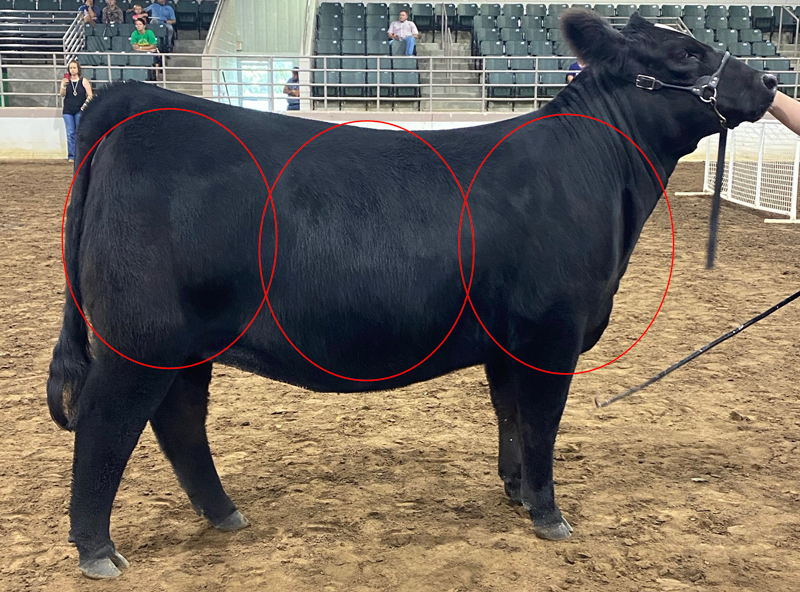
Muscling
Of course, the main product of beef cattle is meat derived from skeletal muscle. Muscle also is essential for productivity as it is one component of overall stoutness, along with bone and body volume. An adequate amount of stoutness in the form of muscling is an essential component for breeding cattle to maintain ideal body condition and strength necessary for grazing in a typical beef operation.
Extreme differences in muscling are easily noticeable when comparing two animals. Muscling visually appears to have curvature and a rounded shape (Figure 3). However, it should be noted that ideal muscling in females looks different than ideal muscling in bulls. Females should have a long, smooth muscle pattern that still appears feminine whereas bulls tend to be more bulky and expressively muscled. Generally, cattle with adequate muscle will have adequate skeletal width. In contrast, light-muscled cattle will have a narrow skeletal design. These differences can be most easily assessed and explained on a rear view as shown in Figure 3. When evaluating differences in muscling, the evaluator should consider the muscle shape and skeletal width relative to the age of the animal. The image on the left in Figure 3 has more shape and curvature of muscle, and the rear view looks more rounded. It is typical for heavier-muscled cattle to be wider from pin to pin and hock to hock, and have a wider stance. The bull calf on the left in Figure 3 has more skeletal width as evidenced by more width at the pins, hocks, and feet when standing squarely. Lighter-muscled cattle tend to look like the shape of an upside-down triangle as shown in the image on the right.
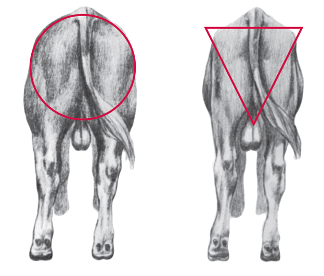
Muscling should not be considered the most important trait for breeding cattle selection. For many evaluators it is often more easily understood and is a good place to start learning to evaluate differences between animals, particularly in yearling cattle and older animals.
The amount of muscling in commercial cows and heifers should be at least moderate. A lack of muscle would imply that there is a lack of stoutness for maintaining body condition and a lack of genetics for muscling to be passed on to future generations or terminal offspring headed for harvest. On the other hand, breeding females with excessive muscling tend to lack maternal traits as compared to more moderately muscled heifers and cows. Muscling is generally antagonistic to fertility and maternal traits. Thus selecting for muscling, a highly heritable trait, can reduce the most important and lucrative aspect of a breeding herd—fertility. This does not mean that selecting for reduced muscling will increase fertility. As previously mentioned, cattle need an adequate amount of stoutness to maintain appropriate body condition and be productive mothers that have a calf approximately every 365 days.
Cattle intended for harvest (terminal cattle) can be bred for increased muscling with fewer negative impacts. Increased muscling improves lean meat yield, growth, finished weight, and dressing percentage. Terminal sires used on commercial cows can quickly increase muscling in a calf crop as muscling is highly heritable. Muscling is somewhat antagonistic to other traits such as marbling (intramuscular fat). Some terminally focused genetics do have both heavy muscling and above-average marbling, but generally cattle with extreme muscling tend to have reduced deposition of intramuscular fat. Selection for extreme muscling has potential downsides even in terminal cattle. In contrast, light-muscled finished cattle will have reduced yield compared to heavier-muscled counterparts, which can result in heavy pricing discounts for yield grade 4 or 5. Muscling in finished cattle should be targeted to achieve a USDA yield grade 1 or 2 without diminishing the opportunity to deposit sufficient marbling for a USDA Quality Grade of low Choice or better.
Body Volume
Body volume is an important component of beef cattle production, and accordingly, is an important component of evaluation and selection. Much like muscling, volume needs to be present in at least adequate amounts. Body volume is a term that encompasses both the thoracic (rib cage) and abdominal cavities. When a beef animal is said to be bigger bodied or have more volume, the rib cage and abdominal areas are larger and more three-dimensional by comparison. Body volume can first be assessed by evaluating the rib cage area of the animal for width and curvature. Flat-ribbed cattle have little noticeable curvature to their rib cage and are generally considered to have less muscling and skeletal width.

Cattle that lack depth of rib are shallow-bodied such as the calf in Figure 4. Shallow-bodied cattle also tend to be shallow-flanked, as shown in this steer. Cattle with depth and spring of rib are more ideal than cattle that are either flat-ribbed and/or shallow-bodied. This is because volume is generally tied to fleshing ability in breeding cattle. Bigger-bodied cattle are generally more apt to maintain their body condition compared to shallow- or flat-ribbed cattle, all other things being equal. Likewise, terminal cattle with adequate body volume are more likely to be faster-gaining and quicker to their ideal compositional endpoint compared to similar cattle with lower volume.
This could be attributed to the dimension needed for the digestive system of the ruminant animal. Table 1 outlines the size of the ruminant stomach. Ruminants’ digestive process requires a lot of volume. In flat-ribbed, one-dimensional cattle the center cavity of the body is condensed, thus compressing the ruminant stomach and visceral organs. This could inhibit the ability of these structures to function at maximum capacity which could limit the energy produced needed for cow maintenance, fleshing ability, and calf development.
| Compartment | Gallons |
|---|---|
| Rumen | 40 |
| Reticulum | 2 |
| Omasum | 3 |
| Abomasum | 4 |
| Note. Adapted from Scientific farm animal production: An introduction to animal science by R. E. Taylor & T. G. Field, 1998, p. 332. Copyright 1998 by Prentice Hall. | |
Structural Correctness
Skeletal soundness is extremely important in breeding cattle as it is a large contributor to longevity. Lameness issues can almost always be linked to a breakdown in structural correctness. Proper skeleton assembly allows for the full range of motion without unnecessary pressure on joints that could create issues as the animal ages.
Structural correctness in cattle has numerous variables and can be challenging for some to assess. There are many skeletal parts that people describe using different words. Structural correctness encompasses the entire skeleton, but most attention is directed toward the feet and legs. Generally, people approach structural assessment starting from front to rear, or from the feet to the spine. Figure 5 demonstrates that the angles to the shoulder, pastern, and femur are near 45°. The bull in the example has a very good slope or angle to his shoulder and pastern. He also has an ideal set to his hock and knee. The bull’s topline is fairly level, and he appears to be adequately level from hooks to pins.
Although a general estimation of structural soundness can be achieved while cattle are standing still, soundness is best evaluated when cattle are in motion. Ideally, the animal should remain level in the topline when moving and the rear feet should cover the tracks of the front feet. Cattle that lack the appropriate angle or are too straight in their shoulder, knee, hock, and/or pastern will consistently take short, choppy strides and plant their back feet short of the tracks their front feet left.
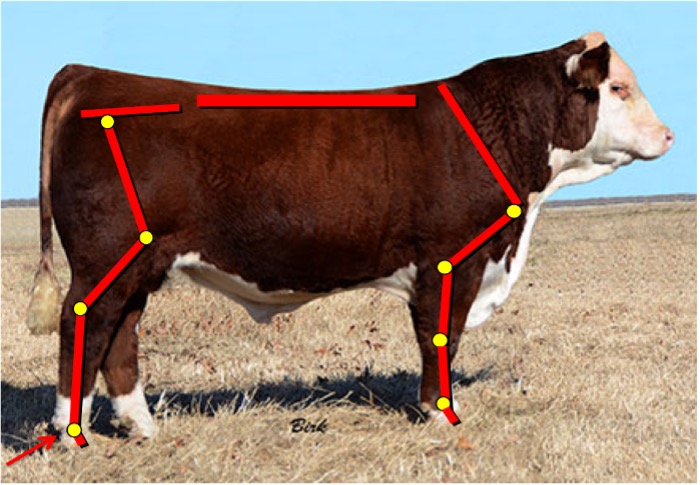
Summary Overview: A Comparison Evaluation of Two Heifers
Comparing the two heifers in Figure 6, one can see that heifer A is better balanced. Heifer A has less proportion of weight in the front third through the neck and shoulder region, and as a result has a greater proportion of weight through the rear third. As such, heifer A is also the more feminine of the two. Heifer B has a short, thick neck and is coarse-shouldered. Heifer B is also carrying more body condition; this is particularly noticeable through the brisket and forerib areas.
Heifers A and B appear to have similar muscling, but considering Heifer B’s lack of rib shape and extra condition, it is likely that Heifer A holds the advantage in muscling (if any).
With regard to body volume, both heifers are deep and appear to have at least adequate volume. Heifer B holds the advantage in total dimension through the middle third. Some of this mass is because of extra flesh depositing through the forerib and lower body. Heifer A exhibits a more maternal body type. In this instance, Heifer A progressively deepens more from forerib to flank which further adds to her advantage in balance compared to Heifer B.
Comparing structures between Heifers A and B should also be helpful in understanding differences in appropriate angles. Heifer A has more slope of shoulder and correspondingly has a more appropriate angle to her front pastern. Heifer B appears to be straight-shouldered and has a steep angle to her pastern. Red lines are included as a visual aide for assessing these angles. Although more challenging to convey in this publication, Heifer A has a better set to her hock. Heifer B appears to be standing with her legs set underneath her, with additional set to her hock which is also known as sickle-hocked. Visualizing these heifers on the move, Heifer B will likely travel with her rear legs reaching forward to stride but will be limited in her ability to fully complete the pushing action of a complete stride.
Although it is ultimately the decision of each owner, Heifer B in many ways is not a viable candidate for replacement if other more soundly structured, more maternal-looking heifers are available. Heifer B, based on visual appraisal, will pass along many of her flaws and may even be a heifer that is less fertile because of being short-necked and coarse-fronted. Heifer B should do well in a terminal scenario if her structural soundness holds up. Herein lies the critical nature of visual evaluation. If heifers like Heifer B are maintained as breeding females, there may be financial losses incurred by developing a heifer that does not stay in the herd long enough to offset those developmental and annual carrying costs.
Conclusion
Not all cattle are created equal. Some breeds, and parent lines within a breed, will favor heavier muscling and stouter attributes, whereas others will exhibit fleshier, more maternal traits. A producer’s intended environment and production goals will dictate the need for specific traits and body types. Visual evaluation along with prudent use of EPDs and other genetic tools can aid producers when making decisions about herd sires, female replacements, and culling decisions.
Reference
Taylor, R. E., & Field, T. G. (1998). Scientific farm animal production: An introduction to animal science (6th ed.). Prentice Hall.
Status and Revision History
Published on Dec 08, 2023
Published on Jan 19, 2024



























































